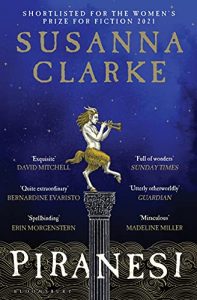PIRANESI by Susanna Clarke (BOOK REVIEW)
Piranesi, by award winning author Susanna Clarke, is a novel which left me awed by its charm and beauty. I had heard much praise for her previous novel Jonathan Strange and Mr Norell, but I hadn’t actually read it myself. However, with Piranesi being rather short, at around 245 pages, I thought this would be a perfect read to sample the author’s work, and I was not left disappointed. Clarke whisked me away on a surreal, magical and somewhat sinister journey, written with such grace.
 Piranesi begins with Clarke throwing us into the middle of the story. Our main protagonist, Piranesi, is a man who believes he is in his thirties, and we immediately see he’s confined inside a house quite like no other. You see The World Piranesi lives in is the House, consisting of a multitude of hallways, corridors and rooms, a labyrinth if you will. The House is frequently hit with Tidal waves, floors are regularly flooded, and Piranesi spends his days tracking where and when the waves will strike next. We also see that Piranesi is fairly secluded, his company consists of the array of statues found in each ‘vestibule’, and the bones of the dead. There is one more living person within the House too though – The Other. An enigmatic character, The Other believes there is A Great and Secret Knowledge hidden somewhere in the World, and once discovered it will grant untold power. Throughout the book Piranesi must aid the Other in his quest to uncover this Knowledge.
Piranesi begins with Clarke throwing us into the middle of the story. Our main protagonist, Piranesi, is a man who believes he is in his thirties, and we immediately see he’s confined inside a house quite like no other. You see The World Piranesi lives in is the House, consisting of a multitude of hallways, corridors and rooms, a labyrinth if you will. The House is frequently hit with Tidal waves, floors are regularly flooded, and Piranesi spends his days tracking where and when the waves will strike next. We also see that Piranesi is fairly secluded, his company consists of the array of statues found in each ‘vestibule’, and the bones of the dead. There is one more living person within the House too though – The Other. An enigmatic character, The Other believes there is A Great and Secret Knowledge hidden somewhere in the World, and once discovered it will grant untold power. Throughout the book Piranesi must aid the Other in his quest to uncover this Knowledge.
The book is written as a series of journal entries made by Piranesi as he records his day to day life within the House. From the onset we discover that he has formed his own unique structural calendar to record the day, month and year of his entries, he has found a sustainable way to source food, and it soon becomes apparent Piranesi has been living within the House for a long time and never leaves. He has a store of stationary, and many other paraphernalia either found around the House, or given by the Other, which frankly begins to raise some questions. We do not know, as Piranesi too does not know, how he came to be in the World of the House. It becomes clear to us that something isn’t quite right, and The Other may hold all the answers.
“The World feels Complete and Whole, and I, its Child, fit into it seamlessly. Nowhere is there any disjuncture where I ought to remember something but do not, where I ought to understand something but do not. The only part of my existence in which I experience any sense of fragmentation is in the strange conversation with the Other. And so I have to ask Myself: whose memory is at fault? Mine or his? Might he in fact be remembering conversations that never happened?”
The more we follow Piranesi‘s character the more empathetic we become to his situation. Although Piranesi shows an almost childlike wonderment at the World around him, and seems content in roaming the House from day to day, we begin to understand that his character suffers from loneliness and seclusion. He finds solace in the statues, such as his favoured Statue of the Faun or the Gorilla, they comfort him in times of distress. He also sees the House through a religious eye, as he believes the House provides for all his wants and needs; he makes offerings to the bones of the People of the Alcove, and he even refers to the rooms as Vestibules. However, by the way he excitedly anticipates his weekly meetings with the Other and looks for clues as to who else may be lurking in the House, we see a desperate need for human companionship. Piranesi is a wholesome, charming character, and the more we discover the more tragic his story becomes.
Both main characters are shown to be academics with the Other claiming to be a scientist, and Piranesi having a wealth of knowledge. Clarke cleverly contrasts the theme of science and magic throughout the book in many ways. She creates this surreal world where we ourselves question if the House is a figment of Piranesi’s imagination or another world? Clarke plays with the theory of the multiverse and other realms, yet she also makes us question if the House is made from magic? Is it a dream? Is the House heaven? We as a reader look for reason in a World that seems highly illogical, and that is what makes Piranesi so highly compelling. The questions keep rolling in our minds right until the very end.
“Is it disrespectful to the House to love some Statues more than others? I sometimes ask Myself this question. It is my belief that the House itself loves and blesses equally everything that it has created. Should I try to do the same? Yet, at the same time, I can see that it is in the nature of men to prefer one thing to another, to find one thing more meaningful than another.”
I was also fascinated by the way Clarke uses juxtapositions throughout the novel. In Piranesi’s World, we’ve already seen how science meets magic, but we are also shown how kindness meets cruelty, classical architecture meets modern day objects, the dead meet the living and reason wars with madness. For example, it is purposely jarring when Piranesi discovers items from our modern, real world, such as ‘crisp packets’ and ‘sandwiches’. It is clearly the outside world which corrupts the purity of the House. Yes, the House holds its dangers, especially with the destructive Tides, but it is also presented as a safe haven, a peaceful, tranquil place to contemplate and find comfort and beauty in the simplicity of life. Clarke’s worldbuilding is complex, vivid, surreal and ever so enchanting.
Throughout this novel I had no idea what to expect, however Clarke won me over with her elegantly crafted prose, Piranesi’s endearing characterisation and the labyrinth of wonders of her World.
“ The Beauty of the House is immeasurable; it’s Kindness infinite.”
Paperback Review copy provided by Ros at Bloomsbury Publishing in exchange for an honest review. Thank you for the copy! Piranesi is available in Paperback today.

